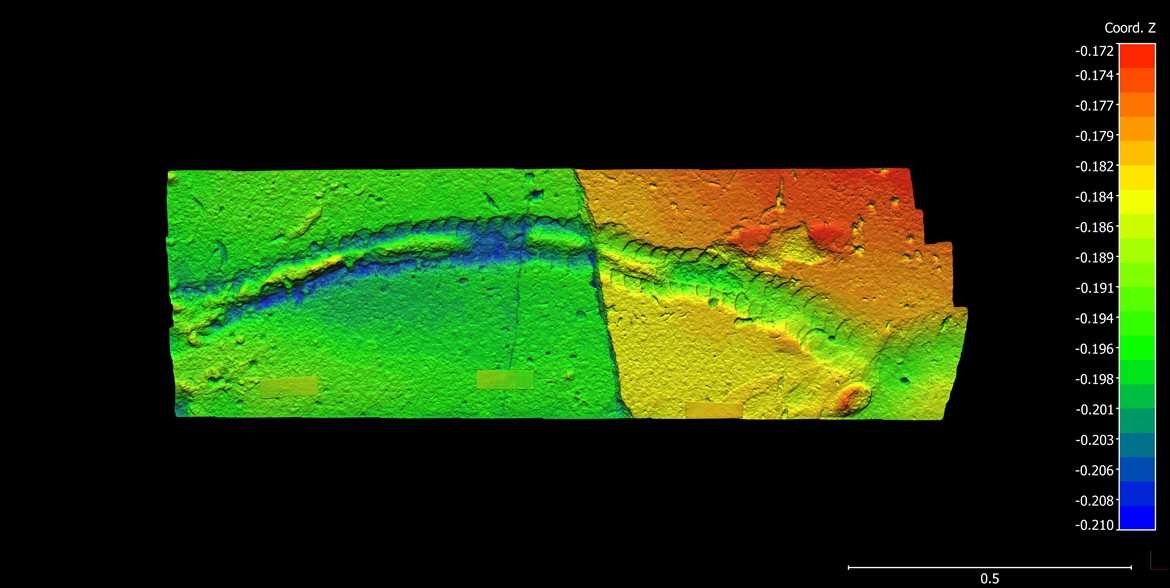Baby sea turtles are cute. They fascinate us as they dig out of their sandy nests and make a run for the sea. But, they face instant danger from voracious birds and other predators, so we cheer them on hoping they will ‘make it’ to the relative safety of their natural habitat, the ocean. Those that make it will not return as breeding adults until they are much larger and perhaps around 20 years old. Thus, they only make tracks on land as hatchlings for the first few minutes of life, and most of these tracks are quickly washed away. So it is perhaps not surprising that fossil trackways of baby sea turtles would prove to be rare.
Until now, in fact, fossil examples were unknown. This changed with discoveries made by South African researcher Jan de Vynck and the team of trackers put together by Charles Helm whose members have been searching the beautiful beaches of the Cape South Coast for footprints made some 100,000 years ago. These date from a time in the Pleistocene Epoch (Quaternary Period) when our species Homo sapiens was just emerging, and ice sheets were advancing and retreating over much of the northern hemisphere.
In a paper published today (Aug 23rd) in the journal Quaternary Research, Helm, de Vynck and colleagues Martin Lockley, Haley Cawthra, Ronel Nel and Richard McCrea have explained the significance of the finds in their paper New fossil sea turtle trackways…from the Pleistocene of South Africa. “Apart from being the first fossil tracks of hatchling sea turtles” said Helm “it is amazing the trails preserve this very brief moment in time.” De Vynck, an expert on early human activity along the Cape South Coast, said he “marveled at the thought that humans may have actually seen these 100,000-year old trackmakers.” He knew he had stumbled on “something extraordinary,” he added, when he found a half dozen nearly parallel trails on a large surface. “It is difficult to escape the conclusion that these were made by hatchlings heading for the sea at the same time” said Haley Cawthra an expert on the sandy beach and dune sediments along the coast.
There was a gasp of surprise when Helm first showed pictures of these tracks at a trackers conference near Cape Town in 2017. Members voted the find the conference’s most significant report. Since de Vynck’s first find he and others have discovered other sites and shown, as turtle expert Ronel Nel explains, that “both Leatherback and Loggerhead hatchlings, with distinctive locomotion patterns” are represented. These turtles are found nesting today around the St Lucia coast, around the Mozambique border, but are rarely active along the Cape South Coast. This tells us “the climate was warmer here in the south when the tracks were made” she said.
Martin Lockley, who has studied turtle tracks from the Age of Dinosaurs in Colorado, says almost all previously-known fossil turtle tracks were made by “fresh water species that lived in lakes and ponds.” Most, he says, have been found and studied in the Northern Hemisphere, in Europe, North America and Asia. Oddly, he explains, there have been two reports, of giant sea turtle tracks from Jurassic rocks in France, but these, he says “were made by giant adults touching the sea bed with their paddles while swimming.” From then on, he added, there is “absolutely no known trace of any kind of sea turtle activity for the next 150 million years.” He and his coauthors coined the scientific term “Marineropodidae” meaning “mariner” or “seafarer foot traces.” The paper suggests an answer to challenging question: how were the trails ever preserved? Most likely, the authors suggest, wind blew fine dry sand over the beach surface where tracks had recently been made in wet sand.
Helm has lead his team to many discoveries in the ancient Cape South Coast beach and dune sands, including tracks of lion, rhino, elephant, giraffe, cape buffalo and various birds. But the teams says the cute baby turtle tracks are “the most exciting find since their 2018 report of human tracks” made by our ancestors on a seaward inclined dune slope. Tracks provide an ecological census of the diverse fauna that inhabited the coast when the human species was young and lived close to nature. The ecology has changed over the last 100,000 years due to natural climate change as well as human hunting activity, and tracks and traces play an important role in documenting these changes. With the sea eroding the coastal sediments, the team predicts that there is much more of scientific interest still to be found. Below a 3D image of 100,000-year old hatchling sea turtle trackway from ancient beach deposits South Africa. These are the first fossil trackways of hatchling sea turtles ever reported.
